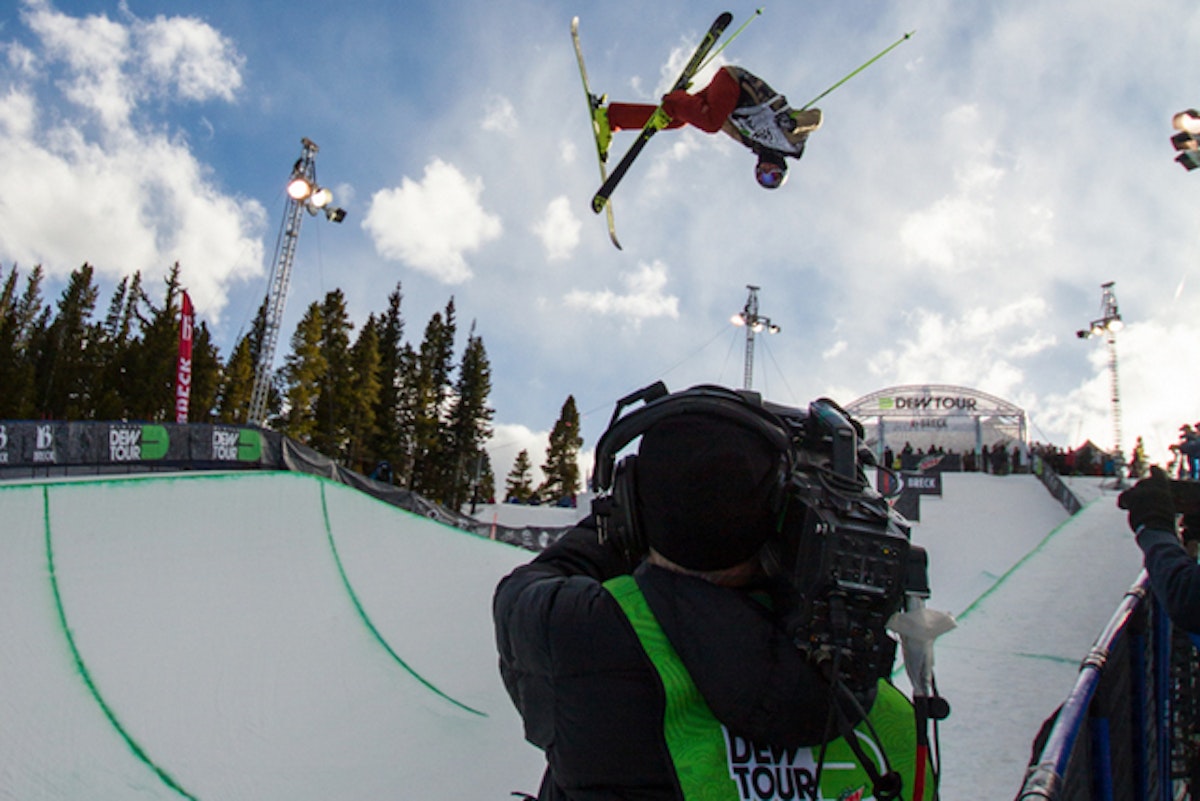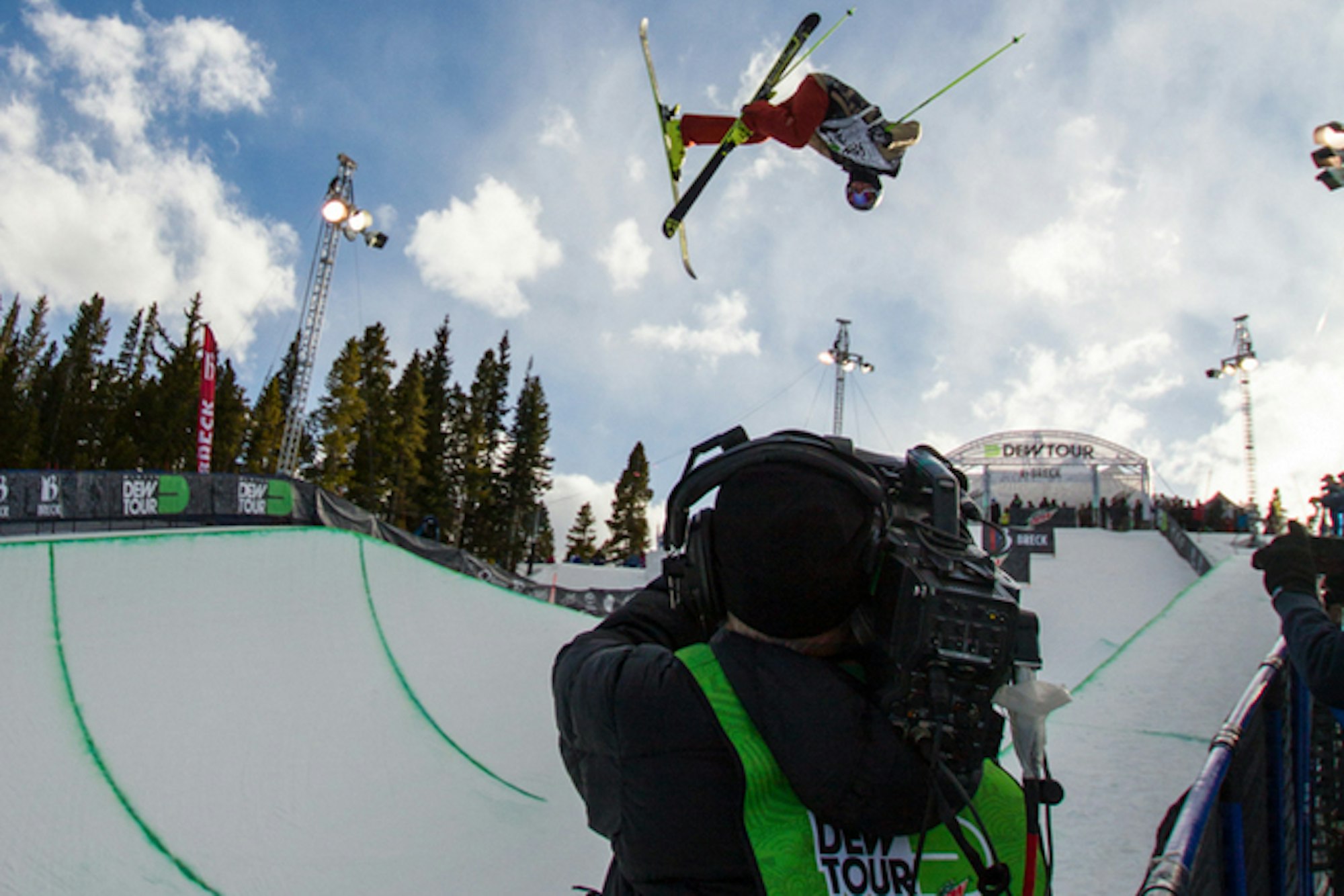South Lake Tahoe-native Kyle Smaine has been competing on the pipe circuit for some time now, and currently sits at number eight on the AFP World Tour halfpipe rankings. He also just took home the top prize in men’s halfpipe in The North Face Park and Pipe Open Series’ first-ever virtual competition. On the heels of a hectic competition season, we caught up with Smaine to get his thoughts on the PPOS, backcountry skiing and more.
Hey Kyle. Thanks for hoppin’ on the phone. Congratulations.
Thanks, man. I’m stoked.
The PPOS changed it up this year. Participants were invited to submit their ideal park and pipe runs in a video edit. What did you think of the change initially? What about now that you’ve gone through it?
When I first heard that they were changing it to a virtual format, obviously I had a lot of questions. We haven’t really seen that, unless you consider Superunknown a virtual contest in that sense. We hadn’t really seen anything like that, so it was the first attempt at it. I really just wanted to see the details and how they were going to put it all together, doing something completely new.
Watch: Kyle Smaine’s winning PPOS halfpipe run.
It’s a really cool idea because there’s so many athletes out there that are really exceptional and unbelievably talented, but sometimes have a hard time with competing. Whether it’s the mental aspect or just being able to put down their best run that they’re capable of on any given day, it doesn’t work for everyone. It’s cool because you get to incorporate those people into a contest environment.
Agreed. Your edit was unique in that, except for the final hit, you included a single pipe run, rather than piecing together shots. Why did you decide to do that?
You know, with the rules of the contest being that you couldn’t have footage from an actual on snow contest, it made it tough for me. I was so busy with contest skiing all year, I didn’t really have much time to break away. Plus, living in Tahoe, we had a horrible snow year and there wasn’t a 22 foot halfpipe built all season, so it really limited my options.
The footage was actually something I filmed for an edit a while back, a couple of seasons ago actually. For me, it’s cool to put something together where you have the whole run, because that’s still a huge aspect of skiing and skiing competitively. Judges notice where you’re able to link all of your tricks and having fluidity throughout the whole run as opposed to just individual maneuvers. That’s how I chose to put my run together and it worked out.
You also won the award for best air for your flat 5 screamin’ seamen.
I didn’t even think about best air when I added that trick in there. That was a trick I used to do in my contest run. I probably did it for a year and a half in competition, but any time I’d try to film it, whether it was with Alex Martini at Dew Tour or anyone else, I could never land the trick. This was the only instance that I ever actually landed that flat 5 screamin’ on film.
Watch: Kyle Smaine with the flat 5 screamin’ seamen.
It’s just unique and a trick that I really love doing. It’s different, no one else really does it, so I really wanted to add that in. Even now, when I have the chance I’d love to be able to add that trick to my contest run. It was cool having the option to do both, I could’ve pieced together a whole run. But the way I did it was to include a whole run, in sequence, but then I wanted to add that one trick in at the end as basically a sixth hit.
So do you prefer the regular competition circuit, or this virtual format?
I love both and believe there’s a place for both. For me, what I love about contest skiing is the mental challenge of it. To be able to arrive to different conditions, whether it’s weather or different pipes, to be able to adapt to the conditions that you’re given and put together your hardest tricks that you possibly can do, all in sequence, is such a challenge. There’s no time when you’re just freeskiing that you do that. You always do a set up trick and then practice your hard tricks. The mental challenge of being able to put it all down in those two runs when it counts is what I find really rewarding about contest skiing.
The virtual contest is just as challenging but in a totally different way. Especially when you look at slopestyle, your only limitations were four rails, four jumps and you could put them in any order you wanted. I thought it was really cool to see how people put together their runs. Noah [Wallace] had three rails, three jumps, a rail and then a jump. It takes just as much planning ahead of time and during the process to put together a good virtual run because you’re thinking, “these are my hardest tricks but I can’t do them in a simple sequence of four rails and four jumps because I don’t land off the rails and jumps the proper way.” Piecing that together and incorporating tricks that are unique and have your own flair to separate you is just as much of a process as showing up at a contest.
Have you seen any of the other entries?
Yeah, I watched a lot of them.
Were there any that stood out to you?
Noah’s and Colby Stevenson’s were unreal. One I really liked watching, he’s a good friend of mine, was Brent Whipple. He threw in all four way doubles, which is impressive. And it really illustrated another aspect of the contest that I like. Brent Whipple blew his knee last June and wasn’t even able to ski park very much all season long. To be able to incorporate your footage and put something together when you’re not able to do any skiing, that’s a unique opportunity in our sport where it’s so easy to get injured and kiss the whole season goodbye.
After perusing your social feeds, it looks like you got after it a bit in the backcountry this season. Is that something you’d like to focus on moving forward?
Yeah, I would love to do more backcountry and skiing for the camera. I grew up ski racing and I love competing but for me it’s the love of skiing that keeps me doing it. I never wanted to be a halfpipe specialist, I just love to ski.
I went to France and the SFR Tour contest was awesome, I skied well, but I was in the Alps, man. I was out there to ski and scare myself. The mountains there are just so much different, and that’s really what it’s about for me, the skiing. I would love to be able to transition to a more backcountry, content-production style of skiing in the future.
— Kyle Smaine (@kylesmaine) March 12, 2015
So, where to from here?
There’s not a lot left this season. I’m not going to go up to WSI in Whistler, just wasn’t in the budget for this year. I’m planning on going down to Mammoth, hopefully they’ll stay open for awhile, but it’s pretty scarce on snow. They have some events coming up, they’re rebuilding the halfpipe and park, then things are closing for camp and stuff. I really want to make it up to West Coast Session this year, it looks super fun and I’d love to be a part of that event. Then, I’ll enjoy a little summer time where I can take a break, decompress and ride my bike.
Nothing quite like a little R&R. Good luck out there, and congratulations again.
Thanks, man.
Related: Jet-lagged world traveler Noah Wallace recaps his recent TNF PPOS grand prize victory



![[GIVEAWAY] Win a Head-to-Toe Ski Setup from IFSA](https://www.datocms-assets.com/163516/1765920344-ifsa.jpg?w=200&h=200&fit=crop)


![[GIVEAWAY] Win a Legendary Ski Trip with Icelantic's Road to the Rocks](https://www.datocms-assets.com/163516/1765233064-r2r26_freeskier_leaderboard1.jpg?auto=format&w=400&h=300&fit=crop&crop=faces,entropy)




![[GIVEAWAY] Win a Head-to-Toe Ski Setup from IFSA](https://www.datocms-assets.com/163516/1765920344-ifsa.jpg?auto=format&w=400&h=300&fit=crop&crop=faces,entropy)


